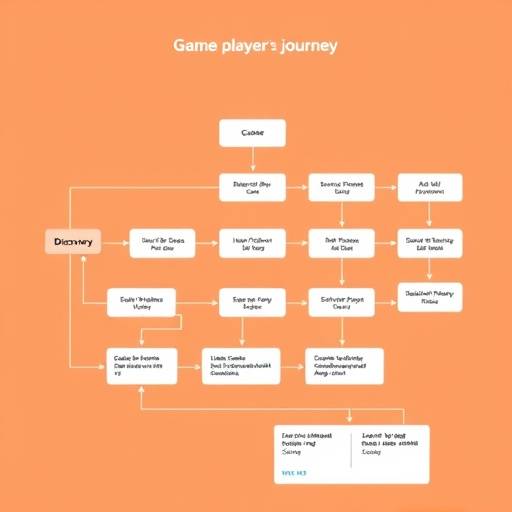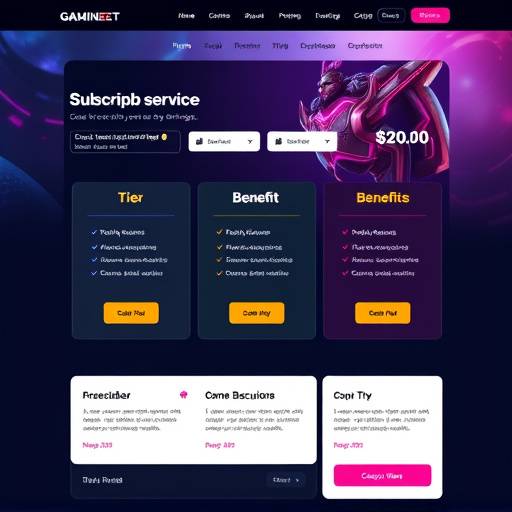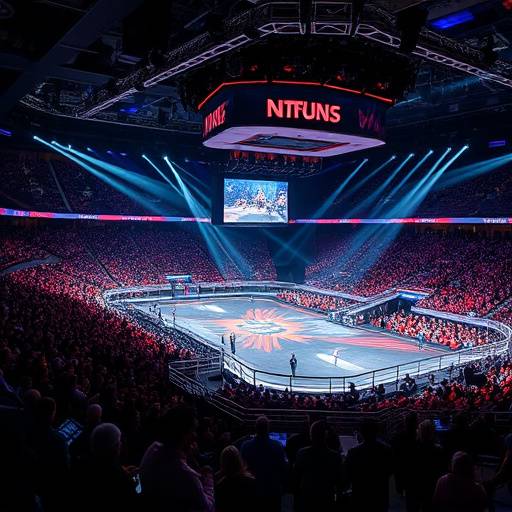The Art and Science of Gaming Monetization
Unlocking value by strategically leveraging player attention. Explore the diverse monetization models that fuel the gaming industry.
Explore Models Connect to EngagementMonetizing Player Attention: A Core Pillar of Gaming Economics
In the vibrant ecosystem of the gaming industry, player attention is the most coveted resource, and effective monetization strategies are the engines that drive innovation and sustainability. At NexusPlay Insights, we dissect the multifaceted approaches developers and publishers employ to transform captivating gameplay and dedicated player time into tangible revenue. Understanding these models is not merely about profit; it's about creating value for players while ensuring the continued creation of the experiences they love.
The shift towards digital distribution and the proliferation of free-to-play (F2P) titles have fundamentally reshaped the monetization landscape. Gone are the days when a single upfront purchase was the only path to profitability. Today, a spectrum of sophisticated techniques exists, each designed to cater to different player preferences and gaming genres, all while strategically capturing and converting player attention.
The core principle remains consistent: a game must first capture and hold a player's attention. Without engagement, no monetization strategy can succeed. This is where the interplay between game design, player psychology, and economic strategy becomes critical. The best monetization models feel like natural extensions of the gameplay, offering meaningful choices and value to the player, rather than intrusive obstacles.

This page will delve into the primary monetization models that define the modern gaming industry, analyzing their strengths, weaknesses, and how they leverage the inherent value of player attention. We will explore the nuances of each approach, providing insights into their successful implementation and the ethical considerations that accompany them.
Key Monetization Models in Gaming

In-App Purchases (IAPs) & Microtransactions
The ubiquitous backbone of the free-to-play model. IAPs range from cosmetic items that personalize a player's experience (skins, emotes) to convenience items that offer a faster progression path or gameplay advantages. Success here hinges on offering desirable items that players feel enhance their enjoyment or status, directly converting their desire for self-expression or efficiency into revenue. The challenge lies in balancing these offerings to avoid pay-to-win scenarios that alienate a significant portion of the player base.
Explore IAPs
Subscription Services
Offering recurring access to a library of games, exclusive content, or premium features for a regular fee. Services like Xbox Game Pass and PlayStation Plus exemplify this model. This strategy thrives on providing consistent value and a curated selection, encouraging players to maintain their subscription for continuous entertainment. It fosters long-term player loyalty by becoming an indispensable part of their gaming habit.
Learn About Subscriptions
In-Game Advertising
From interstitial ads that briefly interrupt gameplay to rewarded video ads offering in-game currency or items for watching, advertising is a significant revenue stream, particularly for mobile games. Strategic placement is key to minimizing disruption and maximizing player willingness to engage. Rewarded ads, in particular, turn passive ad viewing into an active choice that offers tangible benefits, directly linking attention to reward.
Explore Advertising
Esports and Competitive Gaming
The burgeoning world of esports generates revenue through broadcasting rights, sponsorships, ticket sales, merchandise, and in-game items tied to professional teams or events. The intense attention focused on professional play, both from viewers and aspiring players, creates a powerful economic multiplier. This model thrives on community engagement, spectacle, and the aspiration of players to reach professional levels.
Dive into EsportsDeep Dive: In-App Purchases and Microtransactions
In-App Purchases (IAPs) are the cornerstone of the free-to-play revolution, enabling games to be accessible to a broad audience without an upfront cost. This model relies heavily on capturing player attention and fostering a desire for customization, progression, or convenience.
Types of In-App Purchases:
- Cosmetic Items: Skins, outfits, weapon camos, emotes, and other visual enhancements that do not affect gameplay mechanics. These appeal to players' desire for self-expression and social status within the game's community. Games like Fortnite and League of Legends are masters of this.
- Consumables: Items that are used up during gameplay, such as boosts, power-ups, health packs, or crafting materials. These can accelerate progress or help players overcome difficult challenges.
- Durables/Permanent Items: Items that are purchased once and used indefinitely, like new characters, permanent map unlocks, or increased inventory slots.
- Loot Boxes/Gacha Mechanics: Randomized virtual items that players purchase with real money. These tap into psychological principles of variable rewards and the thrill of chance, but are often subject to regulatory scrutiny due to their resemblance to gambling.
The success of IAPs depends on a delicate balance. Developers must offer compelling items that players genuinely want, while ensuring that the core game experience remains enjoyable for those who choose not to spend money. A well-executed IAP strategy enhances the player experience and deepens engagement, transforming fleeting attention into sustained investment.
Consider the case of Genshin Impact . Its gacha system, coupled with a rich open world and frequent content updates, has generated billions in revenue. Players are drawn in by the beautiful world and engaging gameplay, and then invest in acquiring new characters and weapons to enhance their experience and tackle more challenging content. The attention devoted to exploring the vast world and mastering its mechanics directly fuels the desire for new character acquisitions.
Subscription Services: The Value of Access
Subscription models offer a predictable revenue stream for developers and a wealth of content for players. These services are built on the promise of continuous value and an ever-expanding library of entertainment.
Models and Examples:
- Game Pass Models (e.g., Xbox Game Pass, EA Play): Providing access to a large catalog of games for a monthly or annual fee. This model appeals to players who enjoy exploring a variety of titles and value having a consistent source of new entertainment without individual purchases.
- MMO Subscriptions (e.g., World of Warcraft): Traditional model for Massively Multiplayer Online games, requiring a recurring fee for access to the game's persistent world and content updates. This signifies a deep commitment from players and is often associated with extensive gameplay hours.
- Premium Content Subscriptions: Offering exclusive access to premium features, story expansions, or multiplayer modes within a specific game. This can supplement other monetization strategies.
The attention economy plays a vital role here by encouraging players to spend more time within the subscription ecosystem. The more value players perceive from their subscription—through the breadth of games available and the frequency of new additions—the more likely they are to maintain their subscription, ensuring a consistent flow of attention and revenue.
In-Game Advertising: Capturing Fleeting Moments
Advertising within games has evolved significantly, moving beyond simple banner ads to more integrated and player-rewarding formats. For many mobile games, advertising is the primary, and sometimes only, revenue source.
Types of In-Game Ads:
- Interstitial Ads: Full-screen ads that appear at natural breaks in gameplay, such as between levels or after completing a match. Placement is crucial to avoid frustrating players.
- Banner Ads: Small, persistent ads often placed at the edges of the screen. Less intrusive but also less effective at capturing attention.
- Rewarded Video Ads: A highly effective model where players voluntarily watch a video ad in exchange for in-game rewards like currency, extra lives, or power-ups. This format respects player agency and directly links their attention to a tangible benefit.
- Playable Ads: Interactive ads that allow players to briefly try out another game. These are engaging and provide a direct taste of a potential new experience.
The attention economy here is about maximizing the impact of these ads by making them relevant and rewarding. A player's decision to watch a rewarded ad is a direct trade-off: their time and attention for in-game value. This model requires careful implementation to ensure it complements, rather than detracts from, the core gaming experience.
| Model | Primary Attention Leverage | Potential for Player Frustration | Revenue Predictability |
|---|---|---|---|
| In-App Purchases (IAPs) | Desire for customization, progression, and convenience. | High if pay-to-win is perceived. | Moderate to High (depends on player spending habits). |
| Subscription Services | Commitment to ongoing entertainment and a library of content. | Low (if value is consistently delivered). | High (recurring revenue). |
| In-Game Advertising | Voluntary engagement for rewards; passive viewing during breaks. | High if intrusive or frequent. | Moderate to High (depends on player base and ad CPMs). |
| Esports & Merch | Interest in competitive play, fandom, and aspirational goals. | Low (primarily spectator/fan-driven). | Variable (high potential peaks, sponsorship dependent). |
Esports and the Spectacle of Attention
The rise of esports has transformed gaming from a solitary hobby into a globally recognized spectator sport, creating new avenues for monetization fueled by massive audience attention.
Revenue Streams in Esports:
- Media Rights: Broadcasting rights sold to streaming platforms and traditional media outlets.
- Sponsorships: Brands partnering with teams, leagues, and individual players to reach engaged audiences.
- Ticket Sales and Merchandising: Revenue from live events and branded apparel, accessories, and collectibles.
- In-Game Integrations: Special cosmetic items, team icons, or event passes sold within games to support esports ecosystems.
- Prize Pools and Entry Fees: For tournaments and leagues.
The attention drawn to professional esports is phenomenal. Viewership numbers for major tournaments often rival traditional sports. This dedicated attention is incredibly valuable to advertisers and sponsors looking to connect with a passionate, digitally native demographic. The aspirational element—players watching professionals and aiming to emulate their skill—further solidifies this attention loop.
Games like Dota 2 , with its massive The International prize pool funded in part by community contributions via in-game items, exemplify how player attention and investment can directly fuel the competitive scene.
Ethical Monetization: Balancing Profit and Player Well-being
While monetization is essential for the gaming industry's survival and growth, NexusPlay Insights strongly advocates for ethical practices. The commodification of player attention carries significant responsibility.
We believe that successful monetization should:
- Be Transparent: Players should clearly understand what they are purchasing and the terms associated with it.
- Offer Genuine Value: Purchases should enhance the player experience without creating unfair advantages that undermine the core gameplay for non-spending players.
- Respect Player Limits: Avoid predatory mechanics or designs that exploit vulnerable players or encourage excessive spending.
- Prioritize Player Agency: Empower players with choices and control over their spending and engagement.
Our analysis of monetization strategies always considers these ethical dimensions. We aim to provide insights that enable developers to build sustainable businesses while fostering positive and respectful relationships with their player base. The future of gaming monetization lies in models that are both profitable and principled.